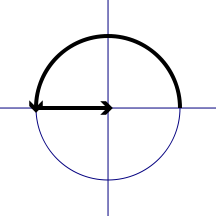| Revision as of 15:33, 24 February 2006 edit142.214.113.96 (talk) →Perceptions of the identity← Previous edit | Revision as of 15:34, 24 February 2006 edit undo142.214.113.96 (talk) →Perceptions of the identityNext edit → | ||
| Line 38: | Line 38: | ||
| ==Perceptions of the identity== | ==Perceptions of the identity== | ||
| cut this shit yo | |||
| == '''''cut the crap''''' == | == '''''cut the crap''''' == | ||
Revision as of 15:34, 24 February 2006

- For other meanings, see Euler function (disambiguation)
In mathematical analysis, Euler's identity is the equation
where
- is Euler's number, the base of the natural logarithm,
- is the imaginary unit, one of the two complex numbers whose square is negative one (the other is ), and
- is Pi, the ratio of the circumference of a circle to its diameter.
Euler's identity is also sometimes called "Euler's equation".
Derivation

The identity is a special case of Euler's formula from complex analysis, which states that
for any real number x. In particular, if , then
- .
Since
and
- ,
it follows that
which gives the identity.
Perceptions of the identity
cut this shit yo
cut the crap
Notes
Template:Ent Maor p. 160 and Kasner and Newman p.103
References
- E. Kasner and J. Newman, Mathematics and the imagination (Bell and Sons, 1949) pp. 103–104
- Maor, Eli, e: The Story of a number (Princeton University Press, 1998), ISBN 0691058547

 is
is  is the
is the  ), and
), and is
is 
 , then
, then
 .
.
 ,
,